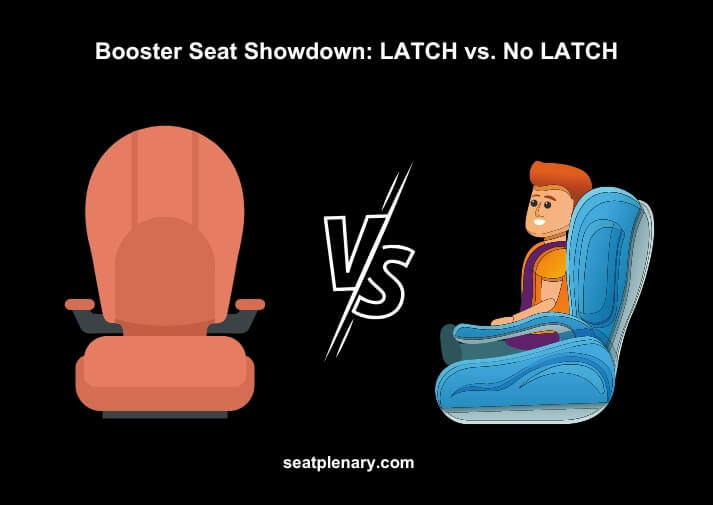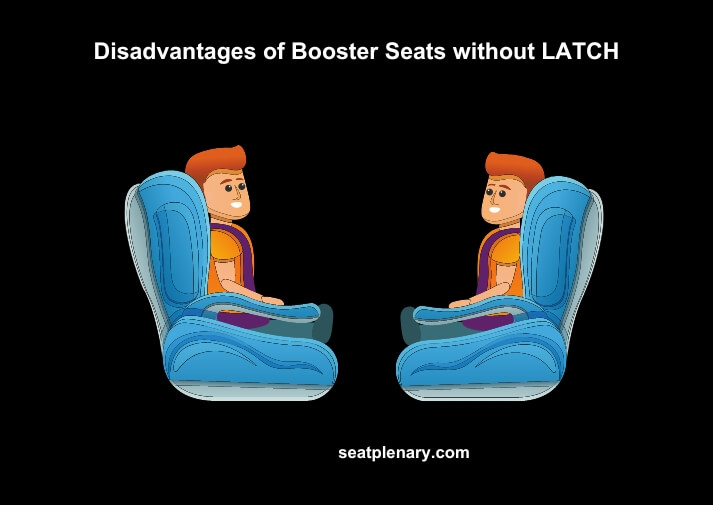The safety of our children is always a top priority, and one of the most crucial ways to keep them protected is by using the right booster seat. With so many options available, it can be challenging to determine whether a LATCH-compatible booster seat or one without LATCH is best for your child. In this article, we will explore the advantages and disadvantages of both LATCH and no LATCH booster seats, providing you with the information you need to make an informed decision.

Understanding Booster Seats
Types of booster seats
There are two primary types of booster seats:
- High-back booster: These seats provide head, neck, and back support, and are especially useful for vehicles without headrests.
- Backless booster: These seats elevate the child to ensure the seat belt fits properly, but do not provide head, neck, or back support.
Age, weight, and height requirements
Generally, children should use a booster seat until they are at least 8 years old, weigh between 40-100 pounds, and are 4 feet 9 inches tall. However, always follow the manufacturer’s guidelines and your state’s laws regarding booster seat use.
Booster seat safety standards
Booster seats must meet the Federal Motor Vehicle Safety Standard 213 (FMVSS 213) to ensure they provide adequate protection.
The LATCH System
Definition and purpose
LATCH, which stands for Lower Anchors and Tethers for Children, is a standardized system designed to make child safety seat installation easier and more secure.
Components
- Lower anchors: These are metal bars located in the vehicle’s seat bight, the area where the seat back and bottom meet.
- Tether anchors: These are metal loops or brackets located on the vehicle’s rear shelf, seat back, or floor.
Compatibility with booster seats
Some booster seats have LATCH connectors that attach to the vehicle’s lower anchors, while others do not. It’s essential to check the compatibility of a booster seat with the LATCH system before purchasing.
Advantages of LATCH-Compatible Booster Seats
Increased stability
LATCH-compatible booster seats provide a more secure fit, minimizing movement during sudden stops or accidents.
Easier installation
The LATCH system simplifies the installation process, making it less likely for parents to install the booster seat incorrectly.
Reduced risk of misuse
By connecting directly to the vehicle’s lower anchors, LATCH-compatible booster seats are less susceptible to user errors, such as loose seat belts.
Compatibility with modern vehicles
Most vehicles manufactured after 2002 are equipped with the LATCH system, making it easier to find a compatible booster seat.
Disadvantages of LATCH-Compatible Booster Seats
Weight limitations
The LATCH system has weight limits, which can vary depending on the vehicle and booster seat. Exceeding these limits can compromise the seat’s safety.

Incompatibility with older vehicles
Older vehicles may not have the LATCH system, making it impossible to use a LATCH-compatible booster seat.
Limited availability and options
Not all booster seats are LATCH-compatible, potentially limiting your choices when shopping for a seat.
Booster Seats without LATCH
Installation using vehicle seat belts
Booster seats without LATCH rely on the vehicle’s seat belt system for installation, which can be less secure if not properly tightened and adjusted.
Potential for improper installation
Without the LATCH system, there is an increased risk of improper installation, which can compromise the safety of the booster seat.
Advantages of no LATCH booster seats
- Wider range of seat options: With no LATCH requirement, you have a broader selection of booster seats to choose from.
- Compatibility with older vehicles: Booster seats without LATCH can be used in vehicles that do not have the LATCH system.
Disadvantages of Booster Seats without LATCH
Less stability
Booster seats without LATCH may not be as stable as their LATCH-compatible counterparts, particularly during abrupt stops or accidents.
Increased risk of misuse
Relying on the vehicle’s seat belt system can increase the chances of user error, such as not securing the seat belt tightly enough.
Dependence on seat belt fit
The safety of a booster seat without LATCH relies heavily on the proper fit of the vehicle’s seat belt, which can vary between vehicles and children.
Real-Life Comparisons: LATCH vs. No LATCH Booster Seats
Case studies
Real-world examples of LATCH and no LATCH booster seats highlight the importance of proper installation, regardless of the type of booster seat used.
Statistical data on safety performance
Studies show that the LATCH system can improve the safety of booster seats when used correctly. However, the most crucial factor remains proper installation and fit.
Expert recommendations
Safety experts emphasize that both LATCH and no LATCH booster seats can provide adequate protection when installed and used correctly. Ultimately, it is crucial to choose a booster seat that is compatible with your vehicle and that you can install correctly.
Factors to Consider when Choosing a Booster Seat
Child’s age, weight, and height
Always follow the manufacturer’s guidelines and state laws regarding the appropriate booster seat for your child.
Vehicle compatibility
Ensure the booster seat you select is compatible with your vehicle’s LATCH system or seat belt configuration.
Ease of use and installation
Choose a booster seat that you feel confident installing and using correctly.
Availability and budget
Consider the range of booster seats available within your budget and prioritize safety features.
Frequently Asked Questions (FAQs)
Can I use LATCH with a backless booster seat?
Some backless booster seats have LATCH connectors, but not all. Always check the manufacturer’s guidelines before using LATCH with a backless booster seat.
Is LATCH always safer than no LATCH?
LATCH can improve the safety of a booster seat when used correctly. However, the most important factor is proper installation and fit, regardless of whether you use LATCH or not.
Can I use both LATCH and the seat belt to secure my child’s booster seat?
Using both LATCH and the seat belt is not recommended, as it can cause compatibility issues and potentially compromise the seat’s safety. Follow the manufacturer’s guidelines for proper installation.
How do I know if my vehicle is LATCH-compatible?
Most vehicles manufactured after 2002 are equipped with the LATCH system. Check your vehicle’s owner’s manual or consult the manufacturer to confirm compatibility.
When should I stop using a booster seat for my child?
Generally, children can stop using a booster seat when they are at least 8 years old, weigh between 40-100 pounds, and are 4 feet 9 inches tall. However, always follow the manufacturer’s guidelines and your state’s laws regarding booster seat use.
Conclusion
The decision between a LATCH-compatible booster seat and one without LATCH ultimately depends on several factors, including your child’s age, weight, and height, your vehicle’s compatibility, and your confidence in installing and using the booster seat correctly. Both LATCH and no LATCH booster seats can provide adequate protection when installed and used properly. By considering the advantages and disadvantages of each type, you can make an informed decision that prioritizes your child’s safety.
Resources for Further Information
Car seat safety organizations
Organizations like the National Highway Traffic Safety Administration (NHTSA) and Safe Kids Worldwide offer valuable resources for parents seeking more information on booster seat safety.
Government resources
Visit your state’s Department of Transportation website or the NHTSA website for the latest booster seat laws and recommendations.
Manufacturer guidelines
Always consult the booster seat manufacturer’s guidelines for proper installation, use, and compatibility information.
By thoroughly researching your options and following expert advice, you can feel confident in choosing the right booster seat for your child, ensuring their safety and comfort on the road.
